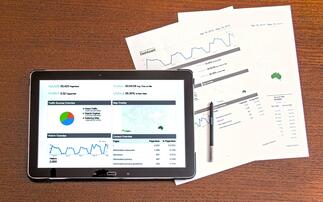LCP’s Ella Purkiss was the winner of the PMI's second student essay competition. In her paper, she sets out her ideas as to what the industry can learn from other sectors when designing and delivering the pensions dashboard.
What did you do with your last pension statement? If I'm honest, I don't quite remember, but it's very likely I looked at it, promised myself I would increase my contributions next year, filed it in a drawer of papers and then moved on.
So how would that change if I could see the information on the pensions dashboard? The intention of the dashboard, according to the Department for Work and Pensions, is that it becomes "a digital interface that will enable people to see all their lifetime pension savings in one place"[1]. This is a laudable aim, and particularly useful for those with a mixture of defined benefit (DB) and defined contribution (DC) pensions, but with DB deferred members declining and the possibility of pot follows member, I would argue that the pensions dashboard's true value is not so much the provision of information as the potential to significantly increase people's engagement with their retirement savings.
By designing a dashboard that encourages interaction and positive behavioural changes, it could bring pensions to life for this and future generations. Let's look at three industries that have increased engagement with their products by making them interactive: banking, utilities and fitness.
Open banking
Like the pensions dashboard, online banking apps contain individuals' financial details, and so must demonstrate that they operate in a secure environment and provide accurate information. Banks not only achieve this individually, but - since January 2018 - larger banks have also been part of the open banking initiative, allowing consumers to view all their accounts in one place. Engagement with this functionality is growing: it was used three million times in July 2018 alone, with an increasing number of firms lining up to join it[2]. Regulated interfaces work behind the scenes to allow consumers to have a holistic view of their finances and switch providers more easily. An ongoing and ambitious project, its successful delivery requires harnessing the expertise of fintech companies to help with the logistics of data sharing, and trusted branding to appeal to consumers[3]. Indeed, the new body responsible for the dashboard, the Money and Pensions Service (MAPS), is already considering what can be learnt from Open Banking[4].
The success of online only bank Monzo also illustrates how engagement with consumers can translate into increased activity (and business growth)[5]. Monzo's app allows consumers to place money in ‘pots' - perhaps one for bills, one for holidays, one for nights out. They can set targets for each pot, receive notifications when they reach their goals or make payments, and easily move money around. A particular favourite with millennials, Monzo's customers prioritise engagement with their budgeting aims over interest bearing accounts (Monzo do not pay interest on their current accounts). Goals and notifications reinforce positive behaviour and make banking more interesting.
Some DC pension providers already offer some of these features - Pension Bee for example allows users to set retirement goals and transfer money from their bank account to their pension pot as either a one off or a regular contribution. They can see how their pension has performed and use the information to make decisions about their future saving (indeed, MAPS will have to consider how the dashboard deals with the provision of advice and guidance). Although these are features well suited to DC pensions, there's little reason why a DB pension cannot also be treated as a pot, albeit one that cannot be contributed to in the same manner. If an individual could see their projected retirement income (both DB and DC), set goals around that and make payments into their DC plan to improve their income all in one place, it would be incredibly powerful and do much to improve people's enthusiasm towards their retirement saving.
Midata
The utilities industry is another sector interested in both the sharing of data and the need to engage consumers. The Midata project - originally intended to be more wide reaching - has been adopted most extensively by the utilities industry. The project aims to standardise the sharing of data (with a focus on data protection) for the benefit of consumers who will be able to make comparisons between providers' various tariffs and analyse their data to "gain insights into their own behaviour"[6].
The logistics of achieving this aim have not been straightforward. Issues such as consumer consent to data sharing and how this consent is verified have slowed the project, and it has taken several years for government to consult on the project and begin to lay down the necessary regulatory framework[7]. The ability to combine data from several sources has proved tricky.
MAPS, then, should not underestimate the task ahead as it builds the 'digital architecture' for the dashboard, particularly given the relatively poor data prevalent in the pensions industry - and the midata project may provide it with some valuable lessons as it seeks to gather and combine data into a single dashboard.
Yet the layperson likely knows little about this project and what happens behind the scenes. If they have an online account with a utilities provider they will not only be able to perform basic tasks such as paying a bill, but also log on and see their usage, compare it to previous periods and perhaps even see how it compares to the average consumption of a household of similar size. This kind of benchmarking is engaging and encourages positive behaviour. Consumers can see if they're using less energy, reducing waste - and therefore saving money - over time. This constant and personal narrative makes an otherwise mundane - and necessary - product come to life, and encourages a level of interaction that benefits both the provider (self-serving customers mean reduced costs for companies) and the consumer.
Fitbit
Arguably the most successful industry at engaging consumers via dashboards and taking them on a personal journey is the fitness industry. This is driven entirely by commercial need: if it doesn't enthuse people then there is no business. Unlike banking and utilities, the use of online fitness apps is much more of a choice. This challenge has not deterred the sector and its success has been exponential, with Fitbit claiming 27.6 million active users in 2018[8].
The Fitbit dashboard offers users a holistic view of their fitness journey, providing them with a wide range of metrics and allowing them to drag and drop their preferred metrics into their own personal dashboard. This allows the user to avoid the risk of information overload and gives them the opportunity to intuitively create an aesthetically pleasing and useful dashboard. It also allows them to set goals from the outset and have a clear vision of their pre-determined target. The dashboard takes users on a journey and - crucially - helps them reach their required destination. It generates notifications at various intervals to congratulate them on progress and encourage them towards their next mini goal. Again, it is this sense of journey that keeps users actively involved with the product.
So what of this particular example can be transferred to the pensions dashboard? The ability of users to curate their own dashboard and include only information they want to look at is useful. Modelling tools can take users on a journey by helping them identify their destination - ie how much money they might require in retirement - and what they need to contribute further in order to get there. For those contributing to DC pots, an Annual Allowance gauge could also prove a useful nudge to those wishing to make use of the tax relief available to them. There is no denying that these tools require a level of digital sophistication that would need to be phased in over time, but neither should this kind of functionality be dismissed as the pensions dashboard develops.
Indeed, I would argue that it is only by being ambitious that the pensions dashboard will reach its full potential - not just as an information hub, but as a means of reinvigorating and reconnecting people with their retirement savings. The examples discussed above are all industries that recognise the power of engaging consumers with their products, using well-designed dashboards that convert user data into user action. The delivery of a truly interactive dashboard will undoubtedly be tough. There is much to get right in terms of the digital architecture and the regulation surrounding it, but there are examples, like midata and Open Banking, to follow and learn from.
Good retirement outcomes require people to be engaged with and take ownership of their retirement savings, even more so since Freedom and Choice. The pensions dashboard is a fantastic opportunity to do just that, but it will require more than simply the provision of information - even if it is online rather than a series of paper statements. Much like banking, paying your gas bill and getting regular exercise, making retirement saving an interactive product could be the step change the next generation of savers needs.
Ella Purkiss is associate consultant at LCP
The Pensions Management Institute's next student essay competition is now underway. The topic is ‘Discuss how data managed by schemes and providers to administer pensions could be used to better segment and target member communications to improve engagement'. The deadline to register to enter is 31 January and deadline to submit is 17 February. Further information can be found on the PMI website.
[1] Money & Pensions Service, 2019.
[2] Forbes, ‘How Open Banking has changed financial services so far', December 2018.
[3] Pinsent Masons and Innovate Finance, ‘The Future of Open Banking, beyond January 2018'.
[4] Department for Work & Pensions, ‘Pensions Dashboards: Government response to the consultation', April 2019, p38-39.
[5] Monzo, '55,000 people open a Monzo bank account every week', 2019.
[6] Department for Business, Innovation & Skills, ‘The midata vision of consumer empowerment', November 2011.
[7] Department for Business, Energy & Industrial Strategy, ‘Implementing midata in the domestic energy sector - Government response to the Call for Evidence', July 2018.
[8] Fitbit, ‘Fitbit reports $571 million Q4 2018 revenue and $1.51 billion FY 2018 revenue', February 2019.







